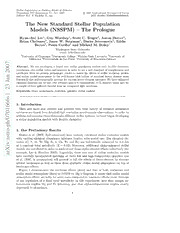
The New Standard Stellar Population Models (NSSPM) -- The Prologue PDF
Preview The New Standard Stellar Population Models (NSSPM) -- The Prologue
Stellar Populations as Building Blocks of Galaxies Proceedings IAU Symposium No. 241, 2007 (cid:13)c 2007International AstronomicalUnion PeletierR.F. & VazdekisA., eds. DOI:00.0000/X000000000000000X The New Standard Stellar Population Models (NSSPM) – The Prologue Hyun-chul Lee1, Guy Worthey1, Scott C. Trager2, Aaron Dotter3, Brian Chaboyer3, Jason W. Ferguson4, Darko Jevremovic5, Eddie Baron5, Paula Coelho6 and Michael M. Briley7 1Washington State University email: [email protected] 2University of Groningen 3Dartmouth College 4Wichita StateUniversity 5Universityof Oklahoma 6Universidadede Sao Paulo 7University of Wisconsin-Oshkosh 7 0 Abstract. We are developing a brand new stellar population models with flexible chemistry 0 (isochrones plus stellar colors and spectra) in order to set a new standard of completeness and 2 excellence. Here we present preliminary results to assess the effects of stellar evolution models n and stellar model atmosphere to the well-known Lick indices at constant heavy element mass a fractionZthatself-consistentlyaccountforvaryingheavyelementmixtures.Wehaveenhanced J chemicalelementsonebyone.Ourultimategoalistodemonstrate10%absolutemeanagesfor 3 a sample of local galaxies derived from an integrated light spectrum. 2 Keywords. Stars: abundances,evolution, galaxies: stellar content 1 v 6 6 1. Introduction 6 1 More and more star clusters and galaxies with wide variety of chemical abundance 0 mixtures are found from detailed high resolution spectroscopic observations. In order to 7 addressandexaminethosechemicallydifferentstellarsystems,wehavebegundeveloping 0 / a stellar population models with flexible chemistry. h p - o 2. Our Preliminary Results r t Dotter et al. (2007, ApJ submitted) have recently calculated stellar evolution models s a with varying chemical abundance mixtures besides solar-scaled one. Ten chemical ele- : ments (C, N, O, Ne, Mg, Si, S, Ca, Ti, and Fe) are individually enhanced by 0.3 dex v i at a constant total metallicity (Z = 0.02). Moreover, additional alpha-enhanced stellar X modelsarecalculatedinordertounderstandthose alpha-elementeffects collectively(for r example, Lee & Worthey 2005). Especially, these new sets of stellar evolution models a have carefully incorporated matching ab initio low and high temperature opacities. Lee et al. (2007, in preparation) will present in full the effects of those element by element altered isochrones as well as those from synthetic stellar model atmosphere on top of isochrones effects. Figure 1 demonstrates the isochrone effects (dots) and that of both isochrones and stellarmodelatmosphere(lines)atFe5270vs.Mgbdiagram.Itseemsthatstellarmodel atmosphereeffects arehefty for some casescomparedto isochroneeffects alone.Because of our regulation of a fixed total metallicity in this experiment, note that oxygen en- hancement implies Mg and Fe deficiency, and that alpha-enhancement implies mostly depressed Fe abundance. 1 2 H.-c. Lee et al. Figure 1. Fe5270 vs. Mg b diagram. At Z = 0.02, individual chemical element enhancement effects (plus Alpha-element enhanced case) are shown at 4, 8, and 12 Gyr (from left to right in each panels). The dots are isochrone effects alone while the lines are isochrone plus stellar model atmosphere effects. Acknowledgements Support for this work was provided by the NSF through grant AST-0307487, the New Standard Stellar Population Models (NSSPM) project. H.-c. Lee also thanks the organizers for their wonderful hospitality and financial support. References Lee, H.-c., & Worthey,G. 2005, ApJS , 160, 176
